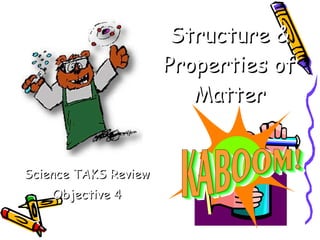
TAKS Review Ppt Objective 4
- 1. Structure & Properties of Matter Science TAKS Review Objective 4
- 4. Density of Steel steel bar The density of steel is the same! Size doesn’t matter! It is a ratio!
- 5. Use the formula sheet – you are given the density and you can read the volume from the cylinder!
- 7. The table shows properties of four liquids that are insoluble in water. If the four liquids are poured into an Erlenmeyer flask containing water, which liquid will form a layer below the water? A Q B R C S D T The density of water is 1 g/ml Anything more than that will sink!
- 8. Buoyancy is the tendency of a less dense substance to float in a more dense liquid. Boats are made so that they have a lower density than water.
- 9. Viscosity is the resistance to flow. Which is more viscous? warm syrup or cold syrup? Cold syrup (high viscosity), because of the strength of attraction between the particles.
- 10. REMINDER: Density is a ratio! As long as the substance is the same – the density is the same!
- 14. Metals Nonmetals Metalloids
- 15. Groups or Family Names 1) ALKALI METALS 2) ALKALINE METALS 17) HALOGENS 18) NOBLE GASES TRANSITIONMETALS Inner earth metals
- 16. Know the properties of the groups/families!!
- 17. 14 Silicon (# protons) Atomic No. Atomic Mass Element Symbol Atoms are Neutral: (#protons = # electrons) Periods (across) Groups/Family (down) Si 28.086 Element Name How many protons? How many electrons? 14 14
- 19. HINT: Same family = similar properties due to same # of valence electrons
- 23. Net Ionic Charges Metals will lose electrons to form positive ions . Nonmetals will gain electrons to form negative ions .
- 29. Has mass and volume (s, l, g) More than one type of matter Uniform throughout (solutions) Not uniform throughout One type of matter One type of atom Two or more elements
- 39. Why are these chemical changes?
- 41. Physical change Chemical change Physical property Physical property Chemical property Physical change Chemical property Chemical change Ice melting Cooking Rocks weathering Conducts electricity Ability to explode Recycled aluminum can Ability to react with acid Burned the popcorn
- 52. Balancing Chemical Equations CH 4 (g) + O 2 (g) CO 2 (g) + H 2 O (g) 1 CH 4 (g) + 2 O 2 (g) 1 CO 2 (g) + 2 H 2 O (g) Place a coefficient in front of the compound to get the same number of atoms in the reactants and in the products. Count the number of atoms on both sides of the arrow.
- 54. Physical States of Water Solid (Ice) Liquid (water) Gas (vapor) Fluids can be gases or liquids. Fluids can flow and take the shape of its container.
- 55. According to the law of conservation of mass, how much zinc was present in the zinc carbonate? A 40 g B 88 g C 104 g D 256 g
- 69. Structure of Water Polar Molecule: Hydrogen: Partial positive ( +) charge Oxygen: Partial negative ( ) charges. Hydrogen Bonding Hydrogen and Oxygen covalently bond to each other.
- 70. Dissolves so many other substances due to its structure/polarity. Water as a Universal Solvent Positive Ion Surrounded by oxygen ( ) Negative Ion Surrounded by hydrogen ( +)
- 87. Concentrations on Solutions Unsaturated Saturated Supersaturated More solvent than solute. Ex. Lightly sweetened Solvent has dissolved all the solute it can hold. Ex. Sweet tea Solvent holds more solute than is normal. Ex. Rock candy Dilute: solution made with little solute. Concentrated: solution made with a lot of solute. Solutions can be solids, liquids, or gases.
- 89. Solubility Factors Solubility increases as the temperature increases for most substances (upward curves) Example: Dissolve sugar in hot tea vs. iced tea Temperature & Solids
- 90. Example: Soda pop What happens when you leave a soda out on a hot day? Solubility Factors Temperature & Gases So keep your soda COLD! Carbon dioxide gas will go out as the soda warms up making it flat. Solubility of gases in water decreases with increasing temperature .
- 92. Gas Laws Boyle's Law: Increase Pressure Decrease Volume Charles' Law: Increase Temperature Increase Volume
- 93. Electrolytic Behavior Non-electrolyte: (ex. pure water) No ions present, thus, no electrical conductivity. Weak electrolyte: (ex.weak acid/base) Few ions present, thus, poor electrical conductivity. Strong electrolyte: (ex. Strong acid/base) Salt completely breaks apart to give more ions , conduct more electricity.
- 95. Neutral Acid Base Acid + Base --> Salt + Water Neutralization Reaction: The pH Scale
- 96. Now You Try!